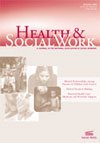 Residential neighborhoods have an effect on residents’ health, according to increasing research in health and social sciences. Neighborhood structural characteristics are consistently associated with individual health outcomes. For example, living in disadvantaged neighborhoods is associated with poorer health and an increased risk of developing chronic conditions such as hypertension. Similarly, neighborhood racial segregation is associated with poorer health for black residents. Studies of neighborhood socioeconomic characteristics and health often suggest that social characteristics of neighborhoods explain why neighborhood demographic composition contributes to resident health—a neighborhood’s social character may cause health-harming stress or may provide health-supporting resources. Yet few studies actually examine whether neighborhood social characteristics contribute to health.
Residential neighborhoods have an effect on residents’ health, according to increasing research in health and social sciences. Neighborhood structural characteristics are consistently associated with individual health outcomes. For example, living in disadvantaged neighborhoods is associated with poorer health and an increased risk of developing chronic conditions such as hypertension. Similarly, neighborhood racial segregation is associated with poorer health for black residents. Studies of neighborhood socioeconomic characteristics and health often suggest that social characteristics of neighborhoods explain why neighborhood demographic composition contributes to resident health—a neighborhood’s social character may cause health-harming stress or may provide health-supporting resources. Yet few studies actually examine whether neighborhood social characteristics contribute to health.
In a recent issue of the journal Health & Social Work, published by NASW Press, Megan E. Gilster, PhD, and Cristian L. Meier, MSW, MPH, published their findings in a study of formal versus informal organizations affecting residents’ health. Their study examined dimensions of one neighborhood social characteristic, social organization, which has been proposed as an important mechanism linking neighborhood structural characteristics to individual outcomes such as health. Neighborhood social organization captures how neighborhoods differentially organize to exert social control over their community. But most studies focus on the capacity of individuals in neighborhoods rather than the capacity of institutions. Social organization of neighborhoods can be divided into categories of formal and informal. A neighborhood’s formal social organization consists of the formal, established organizations that make up neighborhood civic life such as block groups, religious organizations, civic groups, and community organizations. Informal neighborhood social organization, on the other hand, is expressed by residents taking problem-solving actions to address neighborhood issues such as talking to a politician and getting together with neighbors to take action. Both types of social organization reveal the capacity of neighborhoods to realize community-level goals, addressing neighborhood problems and improving the quality of neighborhood life, which may in turn improve resident health.
Social organization is particularly relevant to macro social workers because it presents a shorter-term, modifiable characteristic of neighborhoods that can be the focus of local intervention while addressing longer-term, macroeconomic and political factors that create unequal neighborhoods.
Social organization theory suggests that organizations, such as social services, benefit the neighborhood as a whole as well as to neighborhood residents who do not use the services. Formal neighborhood social organization may therefore affect resident health through its contribution to neighborhood social control, rather than through services provided to individuals.
The authors found no studies that compared the contributions of formal and informal social organization. Unpacking the contributions of each type of social organization may help inform neighborhood-level interventions for healthier communities. Formal neighborhood social organization may be especially important to transforming neighborhoods for resident health because formal social organization can be bolstered by outside resources. As formal social organization is an overlooked dimension of social organization research, we are particularly interested in whether it is more closely linked to resident health than informal social organization.
The following four hypotheses guided the authors’ study:
- Greater neighborhood formal social organization is associated with better resident self-rated health.
- Greater neighborhood informal social organization is associated with better resident self-rated health.
- Greater neighborhood formal social organization is associated with better self-rated health when controlling for individual participation in community organizations.
- Greater neighborhood formal social organization is more strongly associated with better self-rated health than informal social organization is.
This study used data from the Chicago Community Adult Health Study (CCAHS), which surveyed 3,105 adults from a neighborhood-stratified, multistage probability sample of Chicago residents. Interviewers administered face-to-face surveys with one adult from each sampled household between 2001 and 2003. The response rate was 72 percent. Interviewers asked about respondents’ physical and mental health, activities, and neighborhood perceptions. The CCAHS defined neighborhoods as neighborhood clusters, which were composed of contiguous census tracts, following the Project on Human Development in Chicago Neighborhoods.
This study also used organizational data from InfoUSA, a commercial business database that CCAHS researchers purchased, cleaned, and verified. The data consist of both nonprofit and for-profit businesses with Chicago addresses in November 2002. The data include North American Industry Classification System (NAICS) codes, which classify organizations by type of industry. CCAHS researchers have used InfoUSA data to understand the presence of specific resources in neighborhoods.
The authors’ arrived at some interesting results. In answer to their hypotheses, they discovered:
- The data showed only mixed support for hypothesis 1.
- Measuring collective efficacy showed that it is associated with lower odds of being at or below each level of self-rated health, supporting hypothesis 2.
- The measure of individual participation suggested that the neighborhood-level processes cannot be explained by individual residents’ participation in their neighborhood, which supports hypothesis 3.
- Finally, formal neighborhood social organization remained a significant predictor of self-rated health; higher neighborhood organizational participation was associated with a lower likelihood of being at or below each level of self-rated health, supporting hypothesis 4.
In sum, the data show that formal social organization continued to predict better self-rated health when controlling for individual participation. Findings from this study show that organizations have positive neighborhood externalities. This research has implications for policy and practice to improve neighborhoods and resident health.
The authors conclude that:
This study advances neighborhood effects research by explicating the links between neighborhood context and individual health outcomes. Future research should continue to examine how these different aspects of neighborhood social organization contribute to both physical and mental health. Longitudinal research on these relationships would be especially important to understand the extent to which neighborhood interventions might improve resident health and well-being. More specifically, research on community development and community planning interventions that seek to strengthen formal social organization, and especially resident participation in organizations, may be especially important for improving our understanding of how neighborhoods matter for residents.



